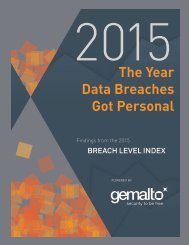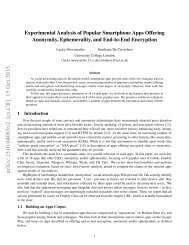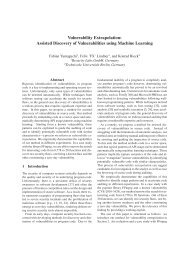Deobfuscating Embedded Malware using Probable-Plaintext Attacks
Deobfuscating Embedded Malware using Probable-Plaintext Attacks
Deobfuscating Embedded Malware using Probable-Plaintext Attacks
Create successful ePaper yourself
Turn your PDF publications into a flip-book with our unique Google optimized e-Paper software.
10 <strong>Deobfuscating</strong> <strong>Embedded</strong> <strong>Malware</strong> <strong>using</strong> <strong>Probable</strong>-<strong>Plaintext</strong> <strong>Attacks</strong><br />
of the analyzed document. Since the Kasiski examination only states that the<br />
distances between identical substrings in the ciphertext refer to multiples of<br />
the key length, it is necessary to also examine the integer factorization thereof.<br />
Fortunately, there exists a shortcut to this factorization step that works very well<br />
in practice: If Kandi returns a key that repeats itself, e.g. 13 37 13 37, this<br />
indicates that we correctly derived the key but under an imprecise assumption<br />
of the key length (l = 4 rather than 2). In such cases we simply collapse the<br />
repeating key and correct the key length accordingly.<br />
3.3 Breaking the Obfuscation<br />
Equipped with an expressive set of probable plaintexts and an estimation of the<br />
key length, it is now possible to mount a probable-plaintext attack against Vigenère-based<br />
obfuscation. The central element of this step is the key elimination<br />
introduced in Section 2.4. It enables us to look for probable plaintexts within the<br />
obfuscated data and derive the used key automatically. Again, Kandi directly<br />
operates on the raw bytes of a document and thereby avoids parsing the file.<br />
Robust Key Recovery. If a probable plaintext is longer than the estimated<br />
key length, the overlapping bytes can be used to reinforce our assumption about<br />
the key. To this end, we define the overlap ratio r that is used to specify how<br />
certain we want to be about a key candidate. The larger r is, the stricter Kandi<br />
operates and the more reliable is the key. If we set r = 0.0, a usual match of<br />
plaintexts is enough to support the evidence of a key candidate. This means<br />
that we will end up with a larger amount of possibly less reliable hints. Our<br />
experiments show that for the grand total incorrect guesses will average out and<br />
in many cases it is possible to reliably deobfuscate embedded malware.<br />
If a more certain decision is desired the overlap ratio r can be increased.<br />
However, for larger values of r we require longer probable plaintexts: r = 0.0<br />
only requires a minimal overlap, r = 0.5 already half of the probable plaintext’s<br />
length and r = 1.0 twice the size. As an example, if the estimated key length is 4<br />
and r = 0.5, only plaintexts of at least 6 bytes are used for the attack. Depending<br />
on the approach chosen to gather probable plaintexts, it might happen that<br />
the length of the available plaintexts ends up being the limiting factor for the<br />
deobfuscation. We will evaluate this in the next section.<br />
Incorporating ROL and ROR. Finally, in order to increase the effectiveness<br />
of Kandi, we additionally consider transpositions <strong>using</strong> ROL and ROR instructions.<br />
ROL and ROR are each others inverse function, that is, when iterating<br />
over all possible shift offsets they generate exactly the same output but in different<br />
order. Furthermore, in most implementations these instructions operate on<br />
8 bits only such that the combined overall number of transpositions to be tested<br />
is very small. Consequently, we simply add a ROL shift as a preprocessing step<br />
to Kandi. Although we attempt to improve over a plain brute-force approach<br />
for breaking obfuscation, we consider the 7 additional tests as a perfectly legit<br />
tradeoff from a pragmatic point of view.









